Text
To[o much] Infinity and Beyond…
Section 1: How we got here
Magic the Gathering is an IP with 30 years of established lore that spans thousands of in-universe years with hundreds of legendary creatures and planeswalkers, all with their own stories to tell. The very concept of planes and planeswalkers (although the status of planeswalkers in the lore seems to be in flux) gives room for new planes with unique characters to be visited at any time, and they can even interact with established creatures across the planes, old and new. The possibilities of the stories to be told are limited only by the creativity of the writing team and the direction they want to take the main story. With the already rich and established lore within its own multiverse, it would be reasonable to assume that Magic would be able to stand on its own without the need for bringing in other brands or IPs. That has not been the direction Hasbro and Wizards of the Coast have gone in over the past few years, however, with the introduction of outside IPs that eventually evolved into the utter takeover that has become Universes Beyond (UB).
I think the first pebble of this avalanche to fall began with the silver-bordered Hasbro IP crossovers Magic made for Hascon 2017.

Initially, these seemed completely harmless and entertaining. Dungeons and Dragons, Transformers and Nerf are all fellow Hasbro owned IPs, and making non-tournament legal cards with these fourth-wall breaking references made for some really cool collectors items. I remember these coming out and how cool I thought they were, the Sword of Dungeons and Dragons in particular. These were very well received, but we had no way to know where this positive reception would lead.
Two years later in 2019, we received the My Little Pony, Extra Life charity promos.

Following a similar formula, these were non-tournament legal promos with another Hasbro IP. It was not for everyone, but it was for a good cause, and opened up Magic to a potentially brand new fan base. Cute, fun, and a harbinger of things to come the following year.
April of 2020 brought Ikoria, Lair of Behemoths, a brand new plane with new characters, mechanics, and marketing strategies. For the first time, booster packs of Ikoria had had the potential of containing a brand new art treatment borrowing from an IP outside of Hasbro: Godzilla

These cards were essentially just alternate art versions of cards that (except for one exception that was later rectified) would have regular, in-universe versions available in the set. The irony of the Godzilla cards is that they gave a perfect blueprint for the non-Magic IP cards, but this blueprint was not used very well after this set. The next and most controversial domino to fall to this point came later that same year.
October of 2020 introduced Universes Beyond via Secret Lair Drop Series: The Walking Dead, and it changed a lot for how other IPs would interact with Magic going forward.
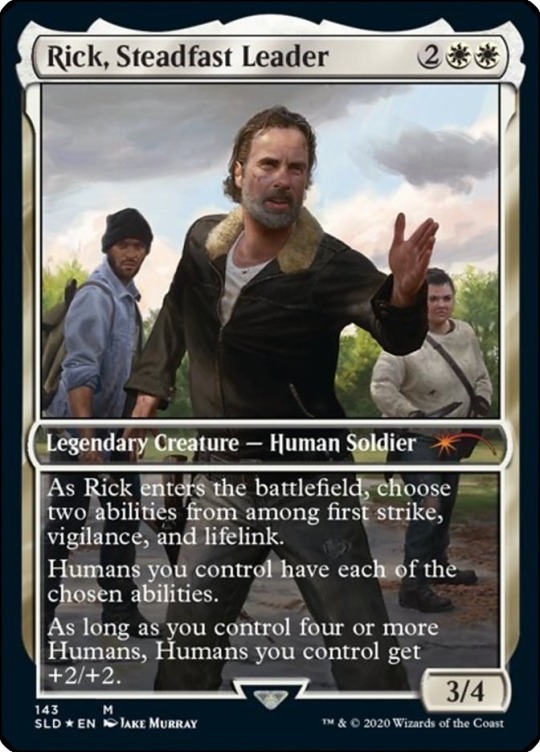
As opposed to the Godzilla re-skins from Ikoria, the Walking Dead (TWD) cards were mechanically unique, black-bordered and therefore eternal format legal, and exclusively available in the Secret Lair for a limited time. This had the Magic community clutching their pearls for a few reasons, the primary of which at the time was the availability of the cards. If any of these cards were extremely powerful or became a combo-piece in any eternal formats, only being available in a Secret Lair would have caused the price of these cards to skyrocket. WotC did acknowledge this and in August of 2023 finally rectified the issue by printing in-universe versions of TWD cards in Wilds of Eldraine, and the cards from the initial Secret Lair drop ultimately did not had much of an impact regardless.
Ultimately, the larger problem Magic players had with this Secret Lair and Universes Beyond as a whole was simple: many Magic the Gathering players do not want other IPs infiltrating their game. This viewpoint has been expressed since the Godzilla cards, and has been voiced again every time a new UB product is announced. It has only been three years since the announcement of UB and I already could not name all of the different releases off the top of my head. In order of release as of October 2023, the following IPs have been used for tournament legal cards: The Walking Dead, Stranger Things, Arcane, Street Fighter, Fortnite, Dracula, Warhammer 40k, Transformers (for real this time), Dungeons and Dragons (twice), The Lord of The Rings, Evil Dead (literally had no clue about this one until writing), The Princess Bride, and Doctor Who. These cards have been printed everywhere and in every form from more re-skins, to exclusive Secret Lair drops, to set boosters, to Commander decks, to entire sets or even all of the above! And more IPs are coming with no end in sight. Jurassic Park, Fallout, Assassin’s Creed and Final Fantasy have been announced for a few weeks now, and just today (10/23/2023) we received news that the Marvel collaboration including multiple sets (similar to LotR) is coming soon as well. The amount of just regular, in-universe Magic product being printed is already incredibly difficult to keep up with, and the speed at which new UB sets are announced and released outpaces it easily.

Section 2: No turning back
Despite objection from the player base from day one, Universes Beyond is not going anywhere. These cards are now an established part of game, going so far as the multiple cards from the Lord of the Rings sets becoming (expensive) staples in both Modern and Commander. Almost every Magic product usually takes a couple of years in development before being ready to release, and with more than 10 UB releases already released in just three years, WotC/Hasbro has clearly been hard at work negotiating these deals with other brands (I have not even mentioned the Hot Pocket, Cheez-it and IHOP collaborations but those are far less consequential so far), and there is no evidence this will be slowing down with no real end in sight. If UB had been limited to IPs set in similar settings to Magic, there may have come a time when they simply ran out of different IPs to use, although even then there would have been plenty to work with for a long time. However, the variety of IPs used has shown there is no limit to what IP they may use, so the only thing stopping it would be the deals happening behind the scenes.
Aside from never running out of IPs, the reality is that a lot of these products have been incredibly well designed and ultimately well received. The Warhammer 40k Commander decks were excellent in both design and flavor, and the LotR set was everywhere upon release (I think this would have been the case even if the One Ring 001/001 promo did not happen too!). Despite not using art with characters from the Magic universe, these cards are generally just really good Magic from a design perspective, and the product tends to sell well. Ultimately, Magic is a really fun game, and getting new cards that are well designed and unique is going to get people excited and buying cards.
Section 3: The Good
So if UB is here to stay, what are the consequences? I will start with what I feel like are the good. Firstly, using other IPs to bring new people unfamiliar with Magic is a win for the game as a whole. Having more people playing Magic is good for everyone who plays as it just means there is a higher chance of the game continuing to exist. More fans equals more people buying cards which equals more Magic. I can imagine that a large number of new players may not have been interested, but then their friend showed them the new set coming out that was Warhammer or Lord of the Rings themed, so they gave it a shot with a precon and fell in love with the game like so many of us have. Additionally, a lot of the IPs selected are excellent choices that I know I have enjoyed and many others have too. The Lord of the Rings was executed extremely well, and I am excited to get my hands on a Doctor Who precon as well. We may never know if the good folks designing Magic are happy about the amount of outside IPs being used, but regardless of their opinions, they are putting love and attention into the design of the cards themselves, and that shines through in how fun and balanced most of these products have been. Finally, I would like to point out that Magic fans have been making outside IP alters and fake cards since photo editing became possible, so there has always been large portion of the fan base that has wanted this exact thing.
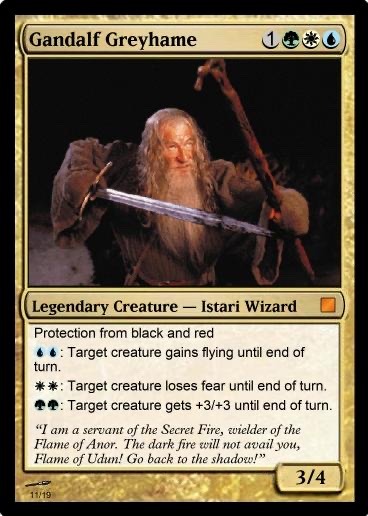
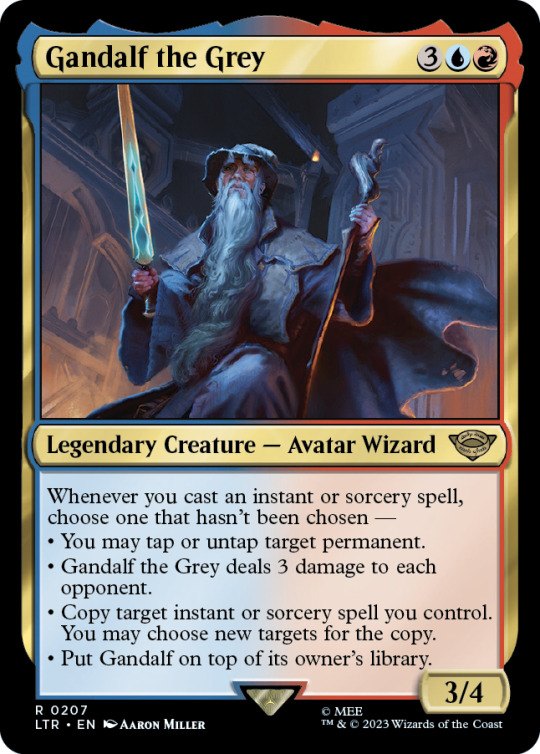
There is true fun to be had sitting down at a table where the commanders are Aragorn, Negan, Eleven partnered with Jim Hopper, and the 11th Doctor! Wanting to deny other people the fun of playing with their favorite fictional characters within their favorite game is not the kind of energy that should be brought to a table. The game is called Magic: the Gathering, and anything that helps bring more people in that are having fun with the game is a net positive.
Section 4: The Bad
As far as the bad goes, there is no shortage of it, most of it is hypothetical. First and most important for me, the endless spoiler season is only made even more overwhelming by UB. I have not truly paid attention to a spoiler season since Double Masters 2022 because the amount of new cards being printed is just too much to keep up with. I fear the game may move past me the same way Yugioh did right around the creation of Xyz monsters and I simply will stop keeping up with it, while remaining a fan.
Another problem UB will continue to create is availability issues. This was a concern from the beginning with TWD, but those cards were not very powerful and therefore the supply has not been an issue. However, the Lord of the Rings set introduced the One Ring and Orchish Bowmasters, both now staples in Modern and Commander and holding prices well above $30.
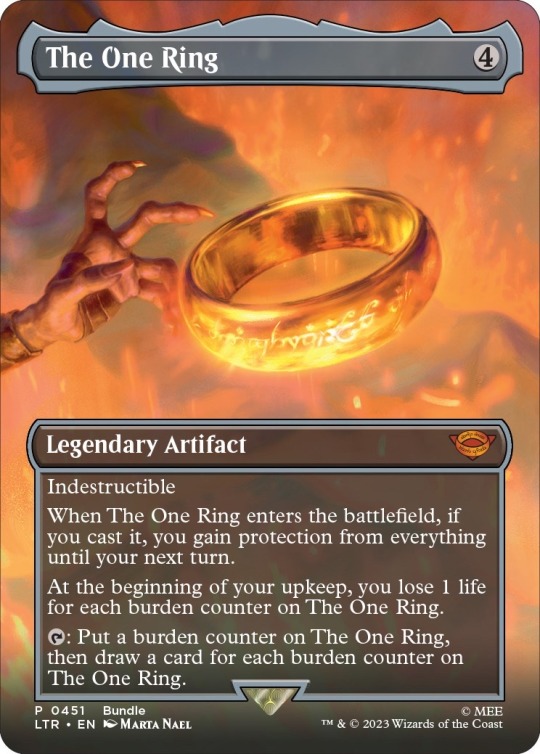
This is not a problem by itself, there are lots of cards that are in the price range throughout all popular Magic formats. The key difference is that cards printed in-universe are much easier to reprint into Masters or Standard sets, which can drop the price if they start creeping too high. This will likely not be an option for cards that are set inside a non-Hasbro IP. If the One Ring eclipses $100 per copy, will they have to make an in-universe version of it, and if so, where will it fit in a set? These questions have answers, but it took them three years to finally print the in-universe versions of TWD cards, so how long will we need to wait for a problem like this to be solved?
The final problem I am worried about with UB is the dilution of Magic as an IP itself. Magic is a pretty lucrative business for Hasbro, so much so that other companies are trying to get their piece of the trading card game pie. Pokémon and Yugioh have been around for a long time, but they are mechanically far enough away from Magic that the competition is not exactly direct. However, Flesh and Blood and more recently Lorcana are here now to try to dethrone Magic as the most popular TCG.
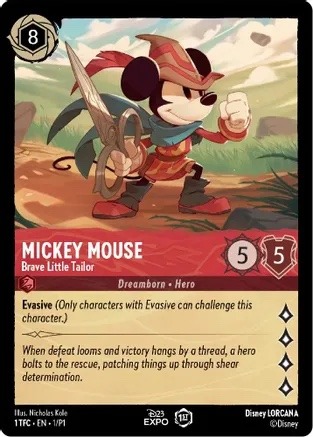
Both draw inspiration directly from Magic for gameplay and rules, and both are coming for the roots of competitive 1v1 gameplay that Magic has focused on far less over the past few years. There are aspects to gameplay that these games simply are doing better right now than Magic, and players are gravitating toward these games for good reason. What does this have to do with UB? Well, as more and more IPs get involved in the mix, the brand of Magic gets harder to find. In the example I gave in the previous section, you could feasibly play a game of Magic in which not a single card features art from the actual IP, and for the folks that have played Magic because they enjoyed the world, lore and art, this is fading into the background of WotC’s priorities. If Magic as a brand becomes too diluted, the gameplay has to continue to be head and shoulders above its competitors to remain relevant, and that gap is closing quickly for competitive gameplay. If too many players get disillusioned with Magic and move to other games with more appealing competitive play, Magic as a whole will inevitably suffer. This remains hypothetical and completely dependent on these other game companies continuing to put love and effort into their games, but it could ultimately be the issue that finally puts Magic in second place.
Section 3: The Ugly
Ultimately, this is the least important point in general but the most important point to me, and it is the aesthetic appeal of these UB cards. I despise the UB triangle symbol and the frames in general are not my favorite either. I will always buy a in-universe printing of a card over the UB, and if a card is UB exclusive, it will never go in a deck of mine unless every other card is also in that frame. Overall, I think the art directors on these cards do a really good job of making sure they still largely feel and look like Magic cards, but that does not mean they hit the mark every time.
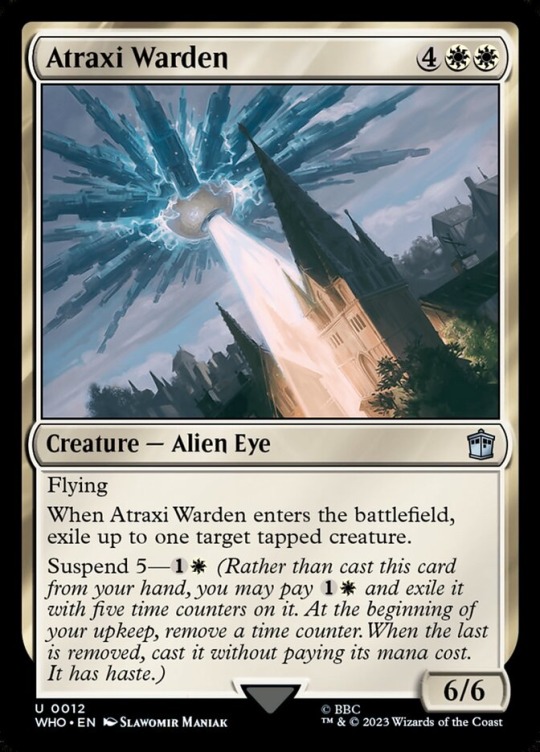
I have no problem with my opponents using the cards, but it really does just keep me from wanting to use certain cards when they just do not look or feel like they game I love.
Conclusions
Universes Beyond is not only sticking around, but seemingly speeding up in production. If you play Magic, you are going to see these cards unless you are only playing with a personal cube. However, I think the quiet majority of players have received it very positively, and sales continue to be good. UB will expand Magic’s footprint to more people and bring new players, and that is good for everyone who loves the game. That being said, UB is going to require WotC to be extra vigilant of the impact of these cards on the game and ensuring they remain accessible, while also cultivating format environments that can compete with the up-and-coming card games that are dipping into their market share. There are legitimate criticisms to these cards both functionally and aesthetically, but as long as the same love and effort continues to go into the design of these collections to keep them fun and balanced, I think they will help Magic, not hurt it. (I can’t lie, I am stoked to have a Captain America deck one day soon)
1 note
·
View note
Text
Flavor Fail: Tales of Middle Earth
Despite a lot of apprehension from the Magic community toward Universes Beyond initially, I think both of the major forays between Warhammer and now The Lord of the Rings feel like home runs to me. The Warhammer decks are spectacular and some of the coolest out of the box precons to date, and the spoilers for Tales of Middle Earth look fantastic from the art to the card design. For me however, there is one glaring problem in one of the single most important elements: the One Ring.
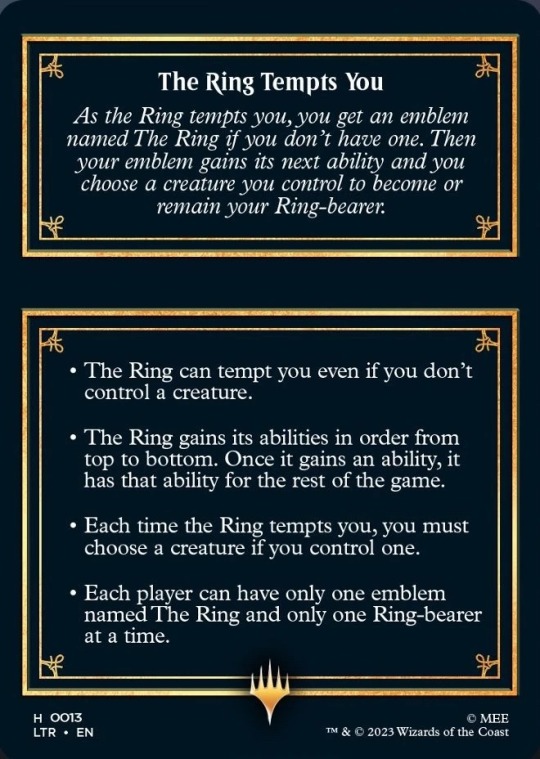
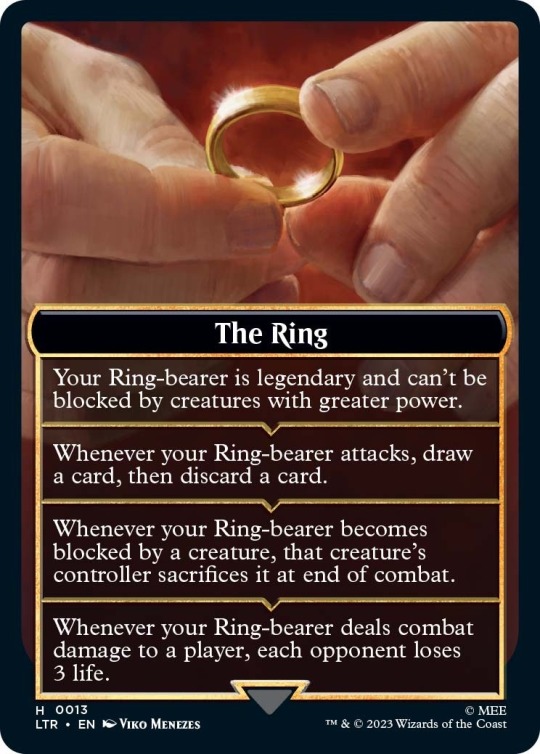
The design of this mechanic just seems backwards compared to what it does in the media. Now, I’m not going to lie and tell you I know the books forward and back. I know there are many details I’m unaware of in the books regarding the powers the ring gives it’s wearer, but the basics are pretty simple. It makes the wearer invisible, but wears the ring-bearer down both physically and mentally. Major short-term upside, but with equally major long-term detriment. So why is this mechanic exclusively positive?
Let’s break it down. I think the first emblem you receive when the ring tempts you is perfect. Any unassuming creature becomes the legendary ring bearer with the ability to get past your opponent’s defenses undetected. Perfect from both a LotR stand point and a Magic combat stand point. Chefs kiss!

The second ability is also fine, I think the ring only providing an advantage strictly for combat would be too under powered for the mechanic to see play anywhere outside of limited, and drawing cards is the most powerful thing you can do in Magic, albeit weak card draw. I like this too.
The third ability is where I start to get a little lost. Forcing your opponent to sacrifice blockers that are literally guaranteed to have less power because of the first ability is both lacking in tangible flavor, and also just not very strong. The first and third abilities are a bit at odds with each other, and I think it would have been better if they just made the creature completely unblockable in the first place. I give this one a D.
The fourth emblem makes absolutely no sense. By the time your creature grants you the fourth emblem, it will likely have been the ring-bearer for a while. You would think there would be some kind of negative effect from prolonged possession of the ring, but instead it gains a completely one sided hit to your opponents life on top of the first three abilities. There is just no negative to being the ring-bearer, which is a hard pivot from the psychological and physical torture we see Gollum, Bilbo and Frodo experience. F-
I also do not understand why it is so easy to move the ring from creature to creature. Every time the Ring tempts you, you have the option to move the ring-bearer power to another creature. This also feels completely at odds with the lore. Every time anyone lost possession of the ring, it became their sole purpose in life to get it back. But now it can just bounce between your creatures and it’s all kumbaya?! It just feels so wrong. I will play devil’s advocate and say maybe they wanted you to feel like Sauron wielding the Ring at the peak of his power, but it just does not deliver the desired flavor.
I’d like to offer my version of the mechanic. Firstly, instead of the Ring effecting the player I want it to stay focused on the creatures, so I will revise “The Ring Tempts You” into the following:
Will of the Ring - If there is not a permanent named The One Ring on the battlefield, create a legendary token artifact equipment named The One Ring and equip it to this creature, and this creature becomes the Ring-bearer. Otherwise, this creature fights the Ring-bearer. If it wins the fight, equip The One Ring to this creature and it becomes the Ring-bearer.
And now for the Ring:
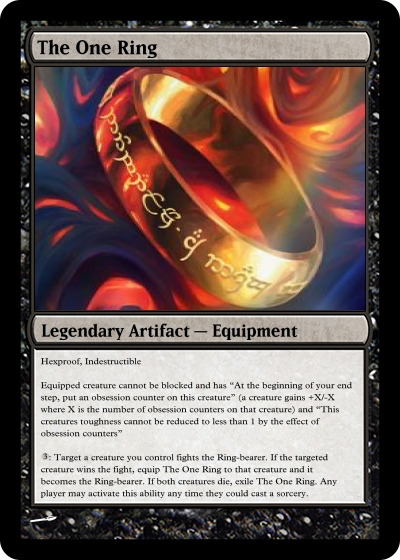
I like this better because it shows the withering yet preserving and empowering effects of the ring over time, as well as the interaction between the Ring-bearer and other creatures coveting the Ring. If both creatures die, the Ring fades from memory until it wills itself back into the world with the help the creature who finds it. Overall, I know it’s a pretty wordy token, but I think it captures the flavor of the ring much better than the mechanic we were left with. How would you create a mechanic that captures the flavor of the IP?
2 notes
·
View notes
Text
Is Toxic Better than Infect?
I had my first experience playing against Toxic this past week at a game store, and it genuinely surprised me! When All Will be One was first previewed and we saw Toxic for the first time, I think most players saw a “fixed” version of infect that was more palatable to the current player base. Infect has a pretty negative reputation in all formats, not just EDH, and Toxic felt like WotC’s way to use poison counters again without reintroducing a largely disliked mechanic. I cannot speak to its current impact in any other format, but (brace for hot take) I think Toxic might not only be better than infect, but a strong mechanic in its own right when it comes to EDH. I will present the qualifier that I only played against it in one session, but the opponent played the deck in two games and the impact was felt heavily in both. I would like to see it more to get a better feel for it, but I genuinely feel like Toxic might have some legs because it gets to fight the battle on two fronts.
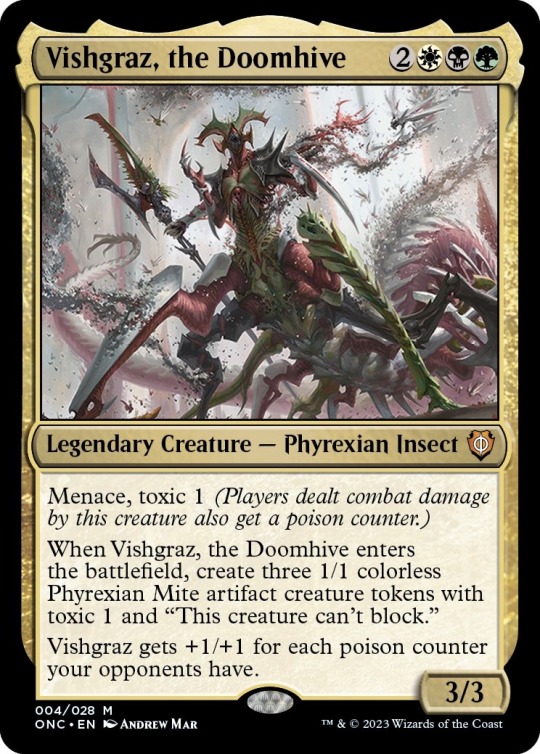
The biggest difference between the two mechanics is what causes poison counters to be applied. Infect is a replacement effect that exchanges damage for an equivalent number of poison counters (or -1/-1 counters on creatures). If you are playing at a table with an infect player, that player is generally going to be the only one who has a win condition of poison counters (if there are multiple infect players at your table, Godspeed friend). For that player, each opponent essentially has a life total of 10, and they have to squeeze in just enough damage to kill everyone. 30 health points between your opponents is a lot less than 120 like a normal game, so they should have a huge advantage, right?
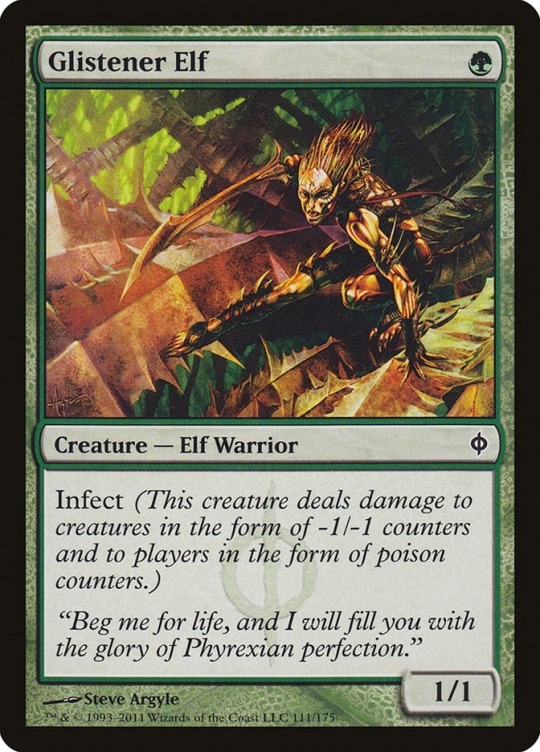
Well, yes and no. They do have way less leg work to do to kill a single player, but that is generally public knowledge, and it changes the behavior of the rest of the table. If everyone started a game of EDH at 10 life, decision making would absolutely be effected. If you are at 40 life and have a 5 power creature swinging at you but have a mana dork available to block that would die after combat, you will probably feel ok taking the 5 damage so you can keep the extra mana next turn. But if that same 5 damage is coming and you are at 10, you almost have to block it or you are going to lose half your life! You will block it, spend a removal spell to get rid of the creature, or you will do your absolute best to hit that player back once your turn comes around. From the start of the game, the infect player is going to be one of the first targets for just about everything, especially once the first poison counter gets attached.
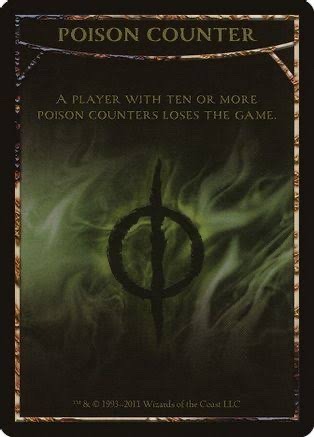
The first poison counter is especially important, because it shapes how the game will look going forward. The Infect player is incentivized to continue to focus on that player because going wide and trying to kill everyone at the same time is generally less efficient and slow, so the game will devolve into a 1v1 between the Infect player and their first “Infectee” until one of them is dead, meanwhile the other two players will largely be left to their own devices. Even if the infect player manages to take out one person, they will be starting from square one with the next player if they have not found a way to chip away at them prior. An infect player may have to deal less damage to knock someone out, but they have a lot of other factors that will be working against them in the meantime.
Now let’s look at Toxic. Toxic X is a triggered ability that triggers when combat damage is dealt, and it assigns X poison counters to the damaged player. The fact that a Toxic creature gets to deal both the damage and give counters means that the Toxic player (pun definitely somewhat intended) is getting the best of both worlds when it comes to combat. The biggest strength here is that the Toxic player does not need to warp their decision making around poison counters. If an infect player is not able to get counters on their opponents, their deck essentially does nothing. A Toxic player on the other hand can handle combat almost completely normally, and the poison counters are just a threatening side effect. They also do not have to dedicate slots in their deck to cards that are focused on adding poison counters. Having cards that care about counters or proliferate is still completely fine, but it is less of a necessity than it would be for the Infect player. Toxic decks can go tall or go wide, and being primarily in Abzan colors gives them access to some of the best combat-centered spells in the game. Carnage Tyrant is already a pretty scary creature to deal with, and it’s Toxic cousin Tyrranax Rex is just as big a threat while the Toxic 4 is just gravy. Black, glistening gravy.

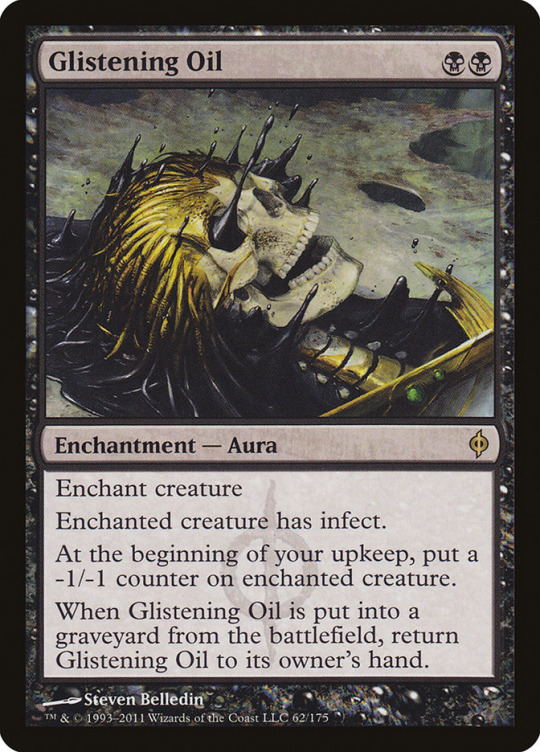
The Toxic player also gets the advantage of not having to dedicate all of their resources to killing one person at a time. They can spread their damage across everyone just like any other deck could, and they can spend time building up their board without looking like they are getting ready to try to one-shot someone. They also are dealing damage with the rest of the table, unlike Infect. Somebody hitting an opponent for 15 damage does not mean much to an Infect player because they do not really have a way to take advantage of it. If an opponent has 3 life left but 0 poison counters, that person is no easier to kill for the infect player than they were when the game started. But the Toxic player can lick their chops and either go in for the kill or try to make a political ally of the endangered player. Does Toxic generally assign less poison counters than Infect? Absolutely. But still being able to deal damage while also giving a couple poison counters is still incredibly strong!
Out in the wilds of your local game store, you are not likely to see a lot of Infect brews. On top of being a narrow strategy that tends to have to focus on one person at a time, the general attitude toward the strategy is largely negative. The only frequent wins caused by Infect will mostly come from a well-timed Triumph of the Hordes or Tainted Strike, and those cards are better outside of an infect strategy when they come as a surprise (targeting an opponent’s creature that is about to deal you lethal damage with a Tainted Strike so you can survive is also a wonderful feeling).

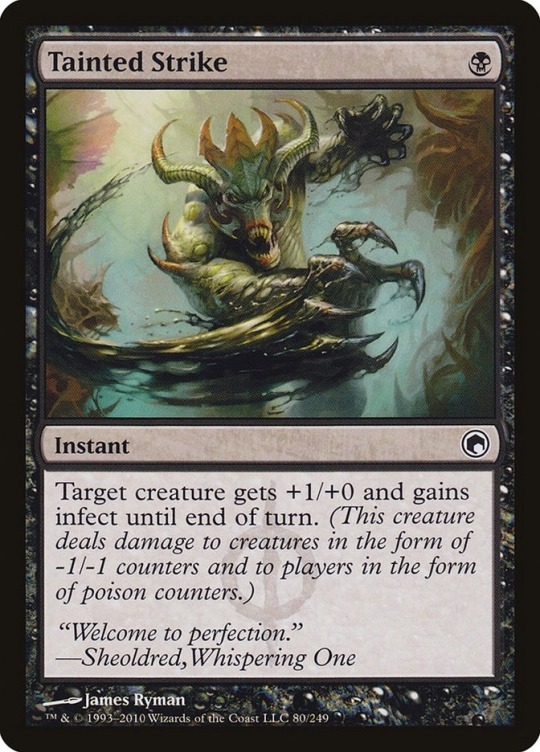
Toxic on the other hand can look and feel like your average Abzan +1/+1 counter deck, while also causing an early knockout here and there through poison. Now, I do not think the attitude of the EDH player base toward Toxic will be much better, but I also do not think anyone will be quite as threatened by it, at least for the time being. Toxic gives the space for a far more flexible game plan than Infect, and because of this, I think there is a real chance that we see some very strong brews in the future as players explore the theme.
1 note
·
View note
Text
Casual Casualties: Playing Mindfully
As Shivam Bhatt has said: “Casual is a mindset, not a power level.” This is a wonderful concept for how I, and many others, like to enjoy Commander. There is nothing wrong with going all out and playing the fastest, most powerful cards and combos ever printed, and EDH is one of the best formats to do so. However, EDH also happens to be the best format for the polar opposite. It’s a place where you can play some of the biggest, silliest, and least powerful cards as well. I land much farther on the casual end, but I can play and enjoy either end of the spectrum. As much as I love relaxed and casual Magic, I feel like the there are some important elements of Magic that get muddled into the mix at many tables. Playing casually and playing well are not mutually exclusive, and in this “Casual Casualties” series of blogs, I want to highlight some things I think are still important to every game, regardless of what power level you like to play at.
Playing Mindfully:
Step one of this process is knowing what the cards in your deck do. This isn’t a quick and easy task by any means, but there is a certain amount of responsibility on every player at the table to know, to at least some extent, what cards they are playing. Do you need to know every interaction possible in a 100 card deck? No. There are literally thousands of possible board states in a single deck, and that’s amazing because variety and surprises are one of the most fulfilling parts of EDH. However, you will get the most out of your decks and have the most fun by knowing what your cards do, and having a general idea of what direction your deck is headed when you’re piloting it. This is also a good way to be respectful of everyone else’s time. If you are playing a complicated card, that’s perfectly fine, but knowing how that card functions and being able to explain it to the rest of the table without a 5 minute discussion will speed things up and help everyone move forward and continue having fun.
The best way to do this is simply to read your cards. The internet has streamlined deck building and made Magic as a whole extremely accessible for almost anyone, regardless of how familiar they are with the game. You don’t need to have thousands of cards memorized to be able to build a strong and cohesive deck, and that’s awesome. However, with this convenience comes unfamiliarity with your cards. You can download a decklist, plug it into CardKingdom, and have the cards at your door, sorted and sleeved within a week. To actually play with the deck though, there is a burden of responsibility on you to know what the cards you are using actually do. This will come naturally as you play the deck, but a good way to get a jumpstart on this process is to read the cards. “Reading the card explains the card” as the Professor always says, and as simple as it sounds, it’s a vital part to mindfully playing.
Ok, you’ve read every card in your deck a couple times and shouldn’t top deck any surprises. Step one down, time to play! You’ve sat down with your play group or at your pod, and you’ve got a nice hand of seven and you’re feeling good. You throw down an turn one Essence Warden and just wait for the value. Everyone is building their board states and you can here the *boop boop* sound in your head every time your life total goes up. But as you and everyone else keeps playing cards, the board gets bigger, there are more and more triggers every time something happens, and your poor little Essence Warden gets missed a few times. Things keep happening and all of sudden you’re facing lethal damage. You look down and see your Essence Warden staring you in the face, and remember all at once all of the extra life you should have at this point. It’s too much to reasonably or accurately count, and you know the fairest thing to do is to take the L.
The only person who should have saved you in this situation is you. And that’s where playing mindfully comes in. Doing your best to keep track of your triggers is a really important part of this. Wether it’s a soul sister, a Saga upkeep trigger, the number of cards in your hand, or a Rhystic Study, paying attention to your board will help you feel like you’re getting the most out of your cards, regardless of the power level. A significant amount of feel-bad moments will be mitigated just by knowing what is happening on your board in relation to everyone else’s. As you become more familiar with your cards and how the deck functions as a whole, this gets easier because you will have a better idea of what your deck needs to do to be successful and how important your effects are to that end. This will also help you notice which cards really aren’t doing much for you, and might be on the chopping block for optimizing your deck. Inevitably, you will still miss triggers here and there. Commander gets complicated, and that 1/1 you played on your first turn can definitely get lost in the mix as the game evolves, and that’s ok. Just make sure you are doing your best to keep track of what you’re doing, and it will do wonders for your overall enjoyment of the games you play.
As you get better at paying attention to your board, you will naturally get better at paying attention to everyone else’s board too. While it is not your responsibility to make sure your opponents are playing their cards correctly, it is good sportsmanship and in the spirit of the casual mindset to lend a hand where you can as other people play. Not everyone has the same amount of time to put into the game and become familiar with so many cards. Some people simply may not be able to keep track of information as easily as other people. Some people might be having a rough day and EDH is not the first thing on their mind at the moment. All of these situations are not only ok, but likely to be something you run into here and there. If you see something, say something. If you notice someone miss a trigger, forget to draw their card for turn, or anything like that, remind them! A big part of the casual mindset is wanting everyone to have fun, and helping everyone keep track of what’s going on helps everyone get the most out of the time you are sharing. It’s hard to be salty toward a player who did everything they could to help you play effectively, and if everyone is looking out for each other, the experience will generally be more positive.
There are probably twenty other topics to include in the realm of playing mindfully, but these are just some thoughts I wanted to put down, and part one of what I assume will be a few of this particular series of blogs. Feel free to share any other ideas you have about playing mindfully, and playing casually in general!
1 note
·
View note
Text
Combat: an Inconvenient Truth
I’m not the first person to say Magic: The Gathering is the greatest game ever invented. From the gameplay, art, lore and collectibility, there is something here for almost anyone. Magic’s many formats are just another example of how much this game has to offer, and Commander, for me and many others, is Magic at is purest and most enjoyable. It’s time meant for the Gathering part in the name. Time for hanging out with your friends and family, sharing drinks and a meal, all while doing shared activity you all take joy in. But that idea is in direct conflict with one of the core parts of the game: combat.
The vast majority of other Magic formats do not have this problem because they are generally not multiplayer. You have a single opponent, and both of you are sitting down in a fight to the death. Even in other multiplayer formats like Two-Headed Giant, there is still a single life total and single enemy you have a goal of defeating. Commander being a 4v4 (sometimes more, sometimes less) introduces a whole new world of politicking, threat assessment, and threat management that is not present in other formats. Part of this is managing combat, and how you use your limited resources as a single player at the table to impact three other players. By tripling your opponents, decision making becomes much more complicated, and can be overwhelming. It also often feels counterintuitive to the reason that you’re there. We are all just here to hang out and have a good time, and it can be hard to balance that when you are sending in your big scary monsters to attack your friends.
Combat is when Commander can get personal. You are directly targeting one of your friends and purposefully attempting to negatively impact their chances of winning the game. Unfortunately, this can lead to players either feeling bad about attacking someone, or not feeling comfortable deciding who they should be attacking and just skipping their combat all together. This leads to many turns that could have had a big impact on the game fizzling into being largely meaningless. I completely understand this feeling, and have been guilty of it in the past. However, I would argue this aversion to combat negatively impacts a lot of games and playgroup metas, and that combat needs to become more normalized.
The first step to this is threat assessment. Deciding who to attack can be especially difficult in the early turns when nobody really has anything too crazy going on, and going to combat feels arbitrary because no one player is positioning themselves to a win. This will lead to many skipped early turn swings as you don’t want to be the first person to make a threat of yourself to the rest of the table. As players cast more spells and do more things, it can become clearer who attackers should be going toward based on their board states. But as board states develop and players have creatures of varying size and effects, combat gets complicated and it can be hard to weigh out the pros and cons of who should be attacked. This often leads to turns of “Well everyone is pretty scary, so I think I’ll just pass the turn.” This literal passing of the buck off to the next player encourages them to do the same if they don’t feel like they have an answer to everything on board, and generally encourages an environment of slower, less efficient play that can lead to long, drawn out two-hour games. Now, if slower drawn out games is what your looking for, more power to you. Personally, I find everyone starts getting a little frustrated when turns are taking close to 10 minutes, the game is rolling into its second hour, and not much is happening. All these skipped combat steps means everyone has had more freedom to build up their boards and assemble their combo pieces or value engines. Sometimes this can be good because it will push a player toward ending the game, but the conclusion may not be as satisfying or may never come if the deck isn’t really built to combo out.
Part of the solution is getting the ball rolling early with combat. If you have that 1/1 on turn two and you’ve got wide open opponents, take a chance and go for a swing. First blood with a 1/1 is largely harmless and shouldn’t earn you a permanent nemesis, and it encourages everyone else to swing when they see an opening too. Setting the tone early will help keep things rolling later. Does that mean you need to swing every combat possible? No. It will sometimes be in your best interest to hold back your blockers, but don’t be afraid of hitting someone when you have to opportunity. Everyone is here to play a game where they are likely to be one of three people who die at the end, so being attacked by another player will not be surprising or unwarranted.
Another important benefit to combat is eliminating your opponents resources. I remember a game I played with my Brago blink deck where I snowballed completely out of control because no one was willing to attack into me, with everyone hoping a board wipe would come instead. But no board wipe came, and because no one tried to hit me, all of my creatures giving me ETB effects stayed around and I kept generating value off of them until my board was so full of cards that it didn’t fit in view of my SpellTable camera. If everyone else had just sent something at me early and often, I might have been forced to pick and choose which creatures I kept, and it would have slowed my snowball of value down before it became unstoppable without a board wipe. It’s similar to the issue with Rhystic Study, where if one person doesn’t pay the one, nobody does, and the Rhystic player draws ten cards and out values everyone else because no one was willing to take a loss. Players need to be willing to lose some of their own pieces to keep someone else from becoming an overwhelming force.
Additionally, don’t be afraid to take someone out completely. Everyone at the table should be fully aware that only one person wins at the end. 75% of the people playing are going to lose, and the odds of them being the other 25% are not particularly high. They will likely lose by your hand or someone else’s, and unless you have been singling them out, it won’t feel any different regardless of where that bitter end is coming from. Be willing to give the death blow if it makes sense, and don’t hold back just because you don’t want to feel like the bad guy.
Combat is supposed to be fun. The rest of the turn is symmetrically structured around the combat step, and it’s one of the most important elements to most games. Declaring attacks and declaring blockers can be cerebral and thought provoking. It can also just be a liberating releasing of your armies of elves or zombies, or a stampede of your big stompy beasts. It can be a single, unassuming creature hiding a combat trick, or the only way out of having your back against the wall otherwise. Combat can and should be a decisive force that drives games to a close, and avoiding it can rob yourself and the rest of the table of more rewarding games. The moral of my story is: swing early, swing often, and normalize combat being a way of keeping the game going as opposed to feeling like your keeping the table from having fun. More efficient games means the possibility of even more games in a single session with different decks, and more fun overall.
1 note
·
View note
Text
Hybrid Mana VS Color Identity
For the second time, I got into a long Twitter discussion in a PleasentKenobi thread about hybrid mana spells in Commander. He is a staunch advocate for an adjustment of the color identity rule, and I am on the other side believing the rule should remain as it is. The topic is more complicated than Twitter replies allow for, so I wanted to jot down my thoughts on it here.
The issue: the color identity rule in Commander does not allow a deck to include cards that have a mana cost, rules text, or color indicator that contains a color that is not present on the deck’s Commander. The color identity rule creates a deck building restriction that prevents you from just playing the best cards in Magic that synergize with your Commander, and instead forces you to remain within the limitations of colors your Commander is. The rule is as central to the format as the singleton requirement is, and is a big part of what makes Commander my favorite format. Hybrid cards conflict with this rule because they are functionally all of the colors present in their mana costs, even though they may be cast with just one of them.
As important as color identity is, the rules of Commader are not chiseled in stone. The banlist is ever changing with cards being added or removed every so often. Additionally, Wizards of the Coast can and has made cards that have forced amendments. Partner changed the minimum deck size from 99 to 98, Planewalkers that can be your Commander changed the rule that your Commander needs to be a legendary creature, and Companions created a whole new zone that allows you to run an extra card if your deck meets their conditions. While I can’t say I am a fan of these mechanics, they did not damage the format in any cataclysmic way, and it still remains the best format for players like me.
I do not believe changing the color identity rule to allow you to run hybrid mana cost cards in decks that do not contain all of the colors in the hybrid symbols would damage the format either. The way decks can be built with this change would not cause a power imbalance in any color or color pairing with the cards currently available, and ultimately, it would just give every deck a few more options. In fact, if my play group decided we wanted to amend this rule, it wouldn’t bother me enough to argue against it, the same way I’m not opposed to a 220 card Battle of Wits deck, or an Un-Commander entering my meta. However, I am opposed to changing the rule in Commander as a whole, simply for how needless it feels, and how complicated it would make the actual definition of color identity.
First, let’s talk about the intent of hybrid mana. Regarding this topic in Commander, Mark Rosewater tweeted: “Here's the problem. Commander's take on hybrid contradicts the design function of it. Hybrid is specifically designed to be used in monocolor decks. Companion, as an example, was designed to be used in monolcolor decks. I get it's also multicolored, but that's a byproduct.”
It’s hard to disagree with Companion, as nothing in the cards even mentions color, and they do function very efficiently as either or both colors. However, many hybrid cards do not read as though they are designed for one color.



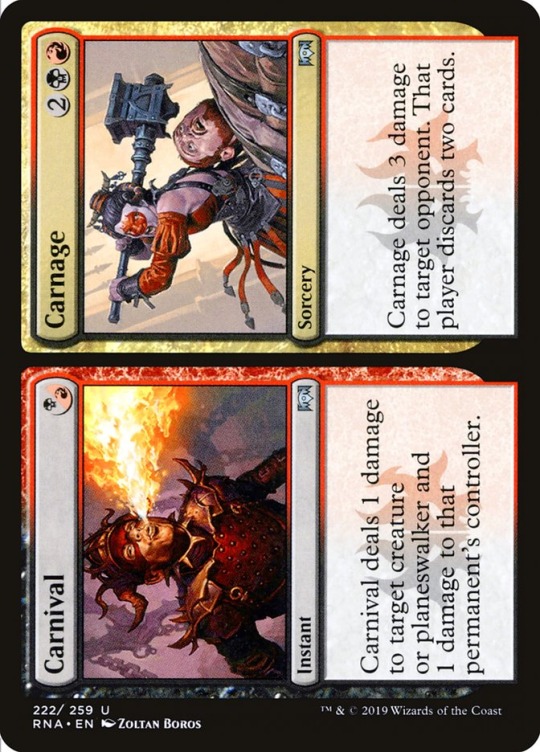
All of the cards above can be cast with just one of the hybrid colors, but incentivize or even require the second color to actually function as the whole card. If you are not playing white and blue, Mistmeadow Witch is a vanilla 1/1 for 2 mana, but if you are using both, it’s now a powerful piece in a blink engine. Maro says the intent is that the cards are to be used in mono-colored decks, but that does not make sense when many of them only function as draft chaff filler in a mono-colored deck. These hybrid cards really only shine when both colors can be used, so playing them in a single color doesn’t really help you if you add it to your deck.
As I said before, changing the rule does not suddenly increase the power level of the format. The vast majority of hybrid cards that even make sense to play in a mono-colored deck have effects that are completely safe and sometimes just slight adjustments to cards already available in either color. Let’s crunch some numbers. There are currently 361 hybrid cards, and all are legal in Commander as long as their colors are within your General’s identity. However, when we actually look at these cards, a pretty significant chunk would not be playable period in a mono-colored decks because even though the cost is hybrid, they have both colors in their rules text or split cost. Removing these cards leaves us at 291. There are also a few like Nightsky Mimic that incentivize the use of both colors to actually gain their effect. There are also multiple vanilla creatures or creatures with a single keyword that have replacements in either color.
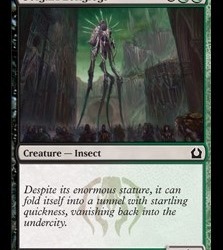

Removing these leaves us with 263 cards. There are more than 25,000 unique cards legal in Commander, and the desired rule change to allow these hybrid cards only really effects these 263, or 1.05%. That number is honestly higher than I expected, but even so, I don’t feel a rule change is warranted to make such a small number of cards playable in an already small selection of decks.
But for the sake of playing devil’s advocate, let’s try and adjust the rule and see what happens. Again, as it is now, the rule is as follows: the color identity rule does not allow a deck to include cards that have a mana cost, rules text, or color indicator that contains a color that is not present on the deck’s Commander. To amend this, we would need to add a clause that says: a deck may include cards with hybrid mana symbols as long as one of the colors present in the hybrid mana cost is shared with the Commander. That’s about the cleanest way I can put it, but this causes a lot of problems when we look at some of the actual cards. First, let’s look at Azorious Guildmage again. Under our new amendment, mono-white now has access to this card now right? Well…no. Azorious Guildmage contains a blue mana symbol in its rules text, which means it still doesn’t follow the rules. And this still does not address Reaper King, Spectral Procession, Beseech the Queen, Flame Javelin and Tower Above. These cards have a hybrid cost requiring just 2 colorless mana or 1 colored mana. These cards are castable in mono-colored decks and that is clearly the intent, but how do I even write the rule that lets these into decks without their color identity? What do we do with these cards?

Mono-colored decks walk a line of being so limited in power that they are pretty exclusively casual, or so busted that they are cEDH playable and don’t need any help. Because of this, the effect of this rule change would largely effect 2 groups: very casual players and newer players. It gives casual players a few extra options for deck building but does not add many (if any) effects their mono-colored deck does not already have access to. However, this does put a new burden of rule comprehension on new players who already have to figure out a pretty complicated format. For me, the juice just does not feel worth the squeeze for a rule change this complicated and yet inconsequential. Especially considering that the color identity rule as is does not leave much grey area for confusion, but changing it could.
0 notes
Text
Trample VS Protection
Keyword abilities are one of the cores of Magic. They are everywhere, and new ones are introduced almost every set. With as many keywords as there are, there are bound to be some complicated interactions between them, and not always necessarily in a way that is intuitive. Knowing how abilities interact with each other is vital to playing effectively, so I will be going through a rules interaction that lost me a game years ago but still gets me fuming whenever I think about it: Trample VS Protection.
First, let’s look at protection. There are a myriad of cards or effects that have or grant “protection from” a myriad of other things. A permanent or player can have protection from colors, card types, other players, or even “everything.”
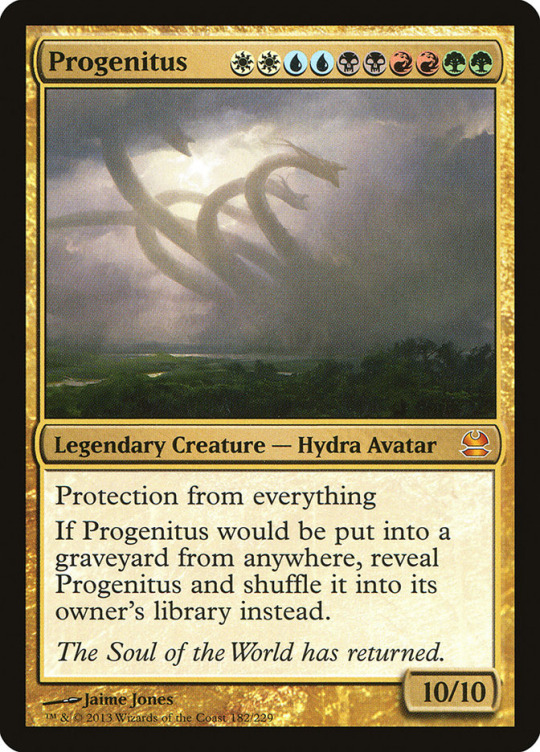
Even writing this post, defining protection is hard. In a not so simple nutshell, protection means that a thing that has protection from X cannot be the target of a spell or ability of X, cannot be dealt damage by X, and cannot be blocked by X. This is far more easily explained with an example. For instance, Teysa, Envoy of Ghosts has protection from creatures. This means she cannot be targeted by an ability from a creature, cannot be dealt damage by a creature, and cannot be blocked by a creature. Teysa is completely unblockable if she attacks, cannot be the target of an ability like Ravenous Chupacabra’s ETB, and can block any creature without the worry of dying from combat damage. But we are going to come back to that last one again in a bit.
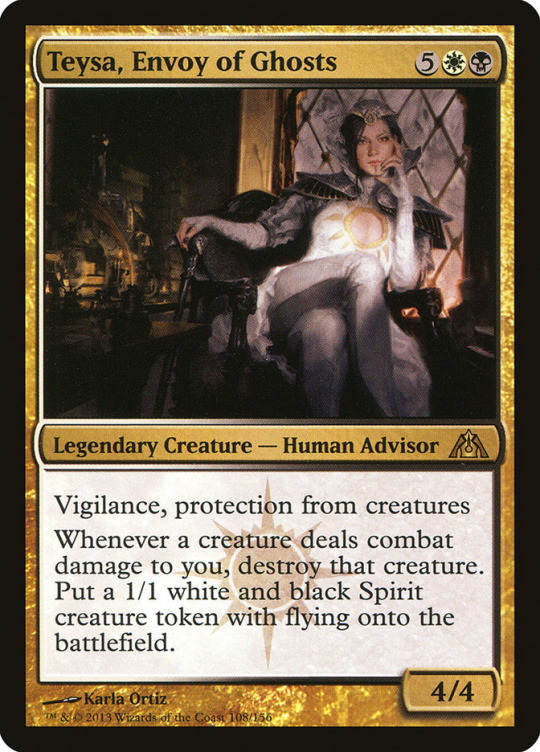
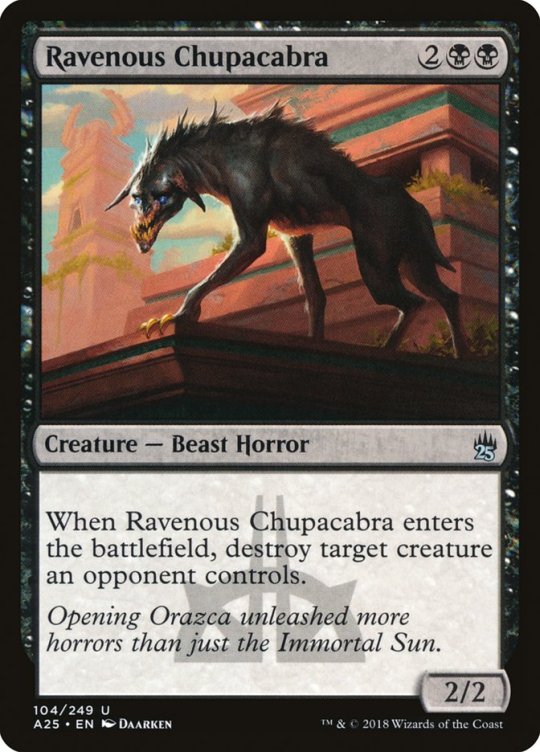
Next let’s talk about trample. Unlike protection, trample can be summed up in one sentence. As a paraphrase, a creature with trample assigns combat damage to a blocker/blockers, and then any damage beyond what is needed to kill the blocking creature(s) is assigned to the player/planeswalker it was attacking. For example, I am at 5 life and my opponent is attacking me with a Colossal Dreadmaw and I have an Elvish Visionary ready to block. If it were a creature without trample, I could just send in my Visionary in to chump block and I would live to see my next top deck. Unfortunately, trample makes it so that instead of my elf valiantly giving its life by exhausting the dinosaur, the Dreadmaw steps on the Visionary with hardly a second thought, and chomps me down Jurassic Park style to 0.
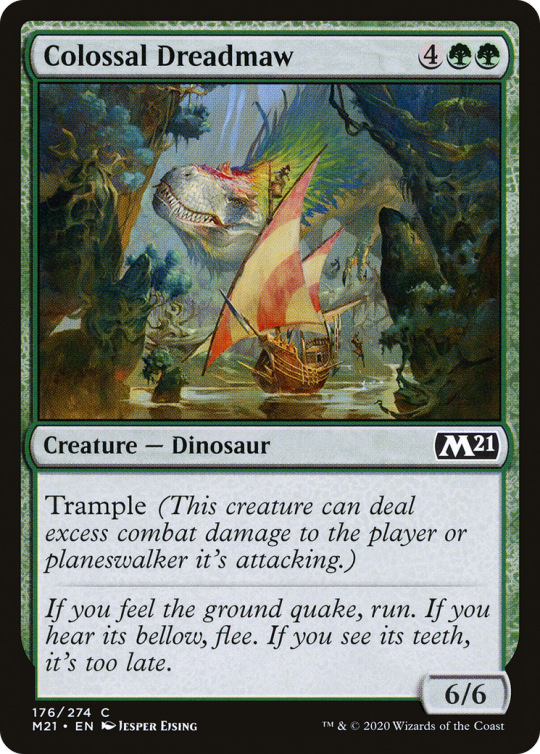
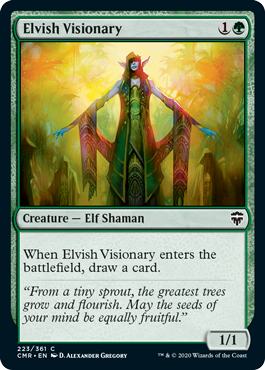
Ok, the exposition is out of the way, here we go. Keyword VS keyword. Trample VS Protection. I again find myself at at 5 life staring down a hungry 6/6 dino. But I’ve been here before, and this time I’ve got a trick up my sleeve: my trusty Coast Watcher. He may be small, but on top of being one handsome bird, he’s got protection from green. This little dude could block every point of damage from a Gigantosaurus and fly away completely unscathed. So the dino charges right through my impervious bird and munches up my remaining life total………Wait what?! My bird had protection from green. It can’t even be dealt damage by a green creature, let alone get killed by one. So why the hell is my life total at 0?! JUDGE!!!
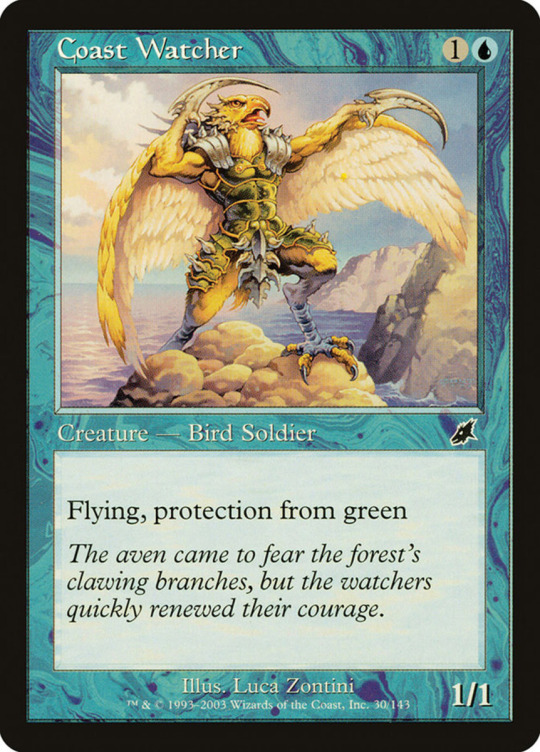
But actually though, what the hell just happened? Well, turns out trample just really doesn’t care. Trample says that any damage in excess of what is required to kill its blockers is assigned directly to the controller. Trample looks at the 1 point of toughness that my creature has, then looks at the 6 points of power on the dinosaur, and gives the bird just what should mathematically kill it, and gives the rest to me. Trample doesn’t care if any damage is actually dealt to a blocker, it only looks at the number it needs to assign to the creature to kill it. Against all logic, my bird is completely unscathed from the block, and I am still dead. Trample doesn’t concern itself with the intricacies of combat, it just looks at the math and does it’s thing.
Let’s play with another keyword: deathtouch. Deathtouch says that any amount of damage this creature deals to another creature is enough to kill the other creature. This means a 1/1 Hornet token with deathtouch can block and kill a 10/10 Gigantosaurus with just the single point of damage it can deal. It also means that an attacking hornet can kill the big lizard with a single sting should the roles be reversed. Now let’s throw deathtouch in our mix.
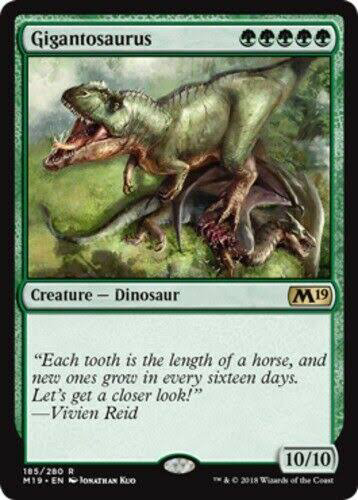

I am staring down the Dreadmaw herself, yet again holding on by the skin of my remaining 5 life. But this time, I came prepared. This time, I conjure up the mighty Aegis of the Heavens. Now my bird doesn’t even need the protection from green to do the job, it’s a 2/8 and should finally hold this dinosaur back and keep my life total untouched. Trample be damned. Wait what is that? Is that dinosaur wearing a choker? Annnnnd I’m dead. Again. HOW?! Turns out that choker she was wearing was coated in a deadly poison that immobilized my bird with just a drop.
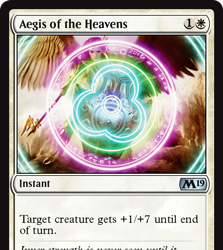

Let’s look at the keywords. Trample only needs to assign what should be lethal damage to a blocker before sending the rest of the damage at me. It’s best friend deathtouch says that just one point of damage is enough to kill any creature. So, as far as trample is concerned, it once again only needs to assign 1 point of damage to the bird and that should kill it, and proceeds to send the remaining 5 straight to me for lethal. Again, trample does not care whether my bird dies, it doesn’t even care if the damage assigned to it actually goes through. It only does the math for what should kill it. No amount of toughness, protection, or even indestructibility would prevent the trample+deathtouch damage from getting through. Absolutely infuriating.
This interaction is an assault on the foundations that my perception of this game is built on. It is both flavorfully and logically confounding. Flavor wise, how is it possible that my magical bird protected by a an infinitely powerful ward against the green forces of nature just be ignored completely? Logically, how can a keyword that only matters when a blocker is involved completely disregard the presence of my blocker? Once I get into the weeds of how trample actually functions inside the computer-like value checks the game of Magic performs constantly behind the scenes, I can finally say I understand what is happening. But I still get to hate that it works that way, and I will never forget how robbed I felt when my game came down to this. My personal beef with this interaction will never die.
2 notes
·
View notes
Text
Proxies at Home and in the Wild:
Using proxy cards in EDH can be a bit of a touchy subject. Most other formats do not need to worry about them because if you are playing Modern, Standard or most other 60 cards formats at your local game store, proxies simply are not allowed. You can’t use fake cards when there are WoTC sanctioned prizes on the line. EDH on the other hand is not played in any kind of sanctioned tournament setting and is widely considered to be a casual and fun environment, so there really aren’t any hard fast rules unless the game store sets them. So how do you feel when you sit down at a table and someone plays a card that was not printed in a WoTC factory?
For me, going to Commander night at my LGS and seeing a proxy is completely fine. The person next to you might be playing a Doubling Season they printed at home and slapped onto a basic land, while the person across from them has a real Tropical Island, Bayou and masterpiece Sol Ring on board. There is always going to be someone with more disposable income than you, or someone who has been playing since Magic first hit the shelves and has a deck worth more than your entire collection combined. The person who just wants to run Doubling Season in their Saproling Tribal deck, but still wants to eat for the rest of the week is not hurting anyone. If the store doesn’t have a problem with it, I certainly don’t either.
Proxies in your playgroup however, can be a different story. Odds are, if you have a group of friends who you see and play with consistently, one person’s deck is going to shape how everyone else’s decks are built. For most people, you might start with precons or just building decks around the cool legendary you drafted when you all pooled some money together and bought a box. But as time goes on and you play more games, you will build more decks, buy more cards, and swap some cards out for an upgrade here and there. This process is natural, and will scale with the competitive spirit of your play group and your collections as they grow.
But then, someone gets a pay raise and has more money to put toward individual cards. Or someone finds a budget decklist or builds an insanely synergistic deck that no one else in the group can keep up with. Part of the playgroup has leveled up, and naturally, everyone else will want to do the same. The easiest way to do this if your personal resources are limited is to proxy. It starts with one card, maybe a Craterhoof Behemoth to just give your elf tribal deck a reliable win con. But then your friend proxies a few shock or fetch lands to make their 3 color vehicles deck more consistent. And then someone else is proxying a Mana Crypt and a Grim Monolith and so on.The freedom to use any card can explode into an arms race of who can make the craziest deck and print out the cards the fastest. Now you’re playing something that looks more like cEDH, and it is nothing like it was at the beginning.
Now, this isn’t necessarily a bad thing. If everyone in your group wants to be playing the fastest, most powerful combos possible, proxying the cards to get there is the cheapest option. I know for me and my group though, that is not what we are aiming for. I have been watching a lot of Playing with Power recently, and as insane and cool as turn 1 Inalla win is to watch, that is not the power level of Magic that we are looking for.
So what is the solution? Can you proxy cards in your playgroup without it spiraling out of control? The answer is absolutely yes. The key here is the same as all other issues people struggle with in EDH, and that’s communication and intent. Talk to your group and ask how they feel about proxies, and just as important, ask them and yourself why you need them. Are you just curving out the top of your deck with a win-condition that’s a little out of your price range? That should be perfectly fine. Are you proxying every black tutor you can think of and along with Exquisite Blood in your Vito deck to power out a combo win by turn 4? Maybe you’re going a little too hard. Again, check with your playgroup, see what everyone is ok with and how you want your games to play out, and then use your printer responsibly along those guidelines. As long as everyone is having a good time, it doesn’t matter if you have 1 proxy or 60 in a deck. Just keep in mind that your standards of what is fun might not be the same as someone outside the group, so don’t just expect everyone you meet to have the same thoughts on proxies.
0 notes
Text
Why I Don’t Like the Zendikar MDFC Lands in Commander:
Kamigawa: Neon Dynasty is here and it brings one of the best cycles of lands ever printed in the channel lands. These are lands that are either just a good old land of the color they provide, or an almost uncounterable situational spell. But these got me stewing on the Zendikar MDFC lands. WHY DO PEOPLE LIKE THESE LANDS!? I remember when they were first spoiled, these cards were hyped up a lot. The Command Zone talked about their potential immediately, and on a recent commander clash podcast, the MTGGoldfish crew had a discussion on them as well, but they were split down the middle on using them or not. And I for one just don’t get it. I feel like I can confidently say that these cards are not generally playable.
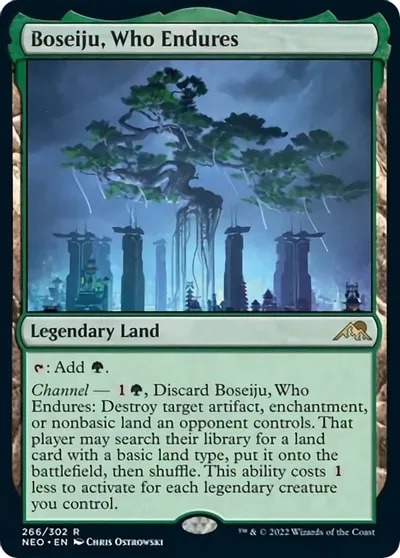
But before I get into that, let’s talk about intent in Commander. Commander is about self-expression and social interaction. If you like these cards, please, play them. Commander should be exactly what you want it to be, and if these cards are how you like to play, you’re doing a great job. It is extremely hard to win consistently in Commander, so your desire when you sit down to play should not be to win with the most optimized deck possible. It should be to have a good time. Jank is cool. I love playing janky cards that are fun and not necessarily optimized, and there’s no problem with that. And just because these cards aren’t generically good, it doesn’t mean they can’t be good in certain decks. All of these cards will find value in a deck that synergizes with them, but that can be said of almost any card. Hell, 2/2 vanilla bears have a really awesome and powerful place in Commander, but that doesnt make them an auto include in every deck.
Now that that’s out of the way, let’s get into why I don’t like these cards. Some of The Goldfish crew mentioned that they are replacing lands in their decks with MDFC lands, because it functions as both the land and a spell. You can run 32 actual lands but technically have 37 lands in total. That sounds great, but that way of thinking about them seems completely backwards once I actually look at the cards and what they do.
Now, I’ll preface this by saying that the mythic cycle of these lands are really good, but that is due almost entirely to the fact that you have the option of having them come in untapped. These cards actually truly represent either a spell or a land in hand, and have great flexibility. Not to mention that the spell sides of these cards are just straight up powerful. These are pretty much an auto-includes in any deck if you can afford them.
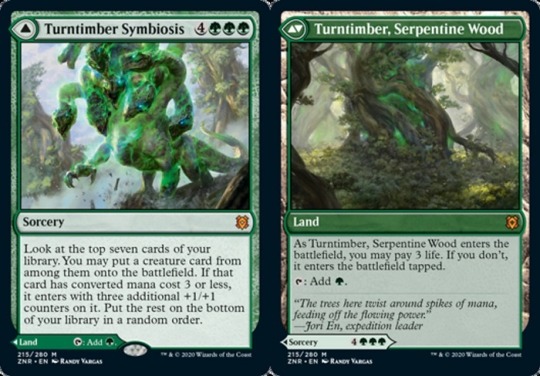
The rest of the MDFC cards however, are pretty underwhelming. My favorite (or least favorite?) example of this is Tangled Florohedron. If you want, you can play it as a strictly worse forest that enters the battle tapped, or, you can play it as a strictly worse Llanowar Elves for 1 and a green. I can only think of 2 situations where running this thing is better than running either a forest or an elf. 1: your deck is landfall and you want as many triggers as possible, or 2: you’re playing elemental tribal and want a trigger off your Risen Reef attached to a mana dork. There is no other situation I can think of where this thing is the better option. If you see this in your opening hand, no worries, easy early turn play. As the game goes on though, I want to see these things less and less. No one wants to play a monocored tap land on turn 5, and it would be infinitely better if it was just the llanowar elf or basic land from that point on. Now this is a dissection of one card, but most of them are like this. Most of them are draft chaff spells on one side, and mono colored tap lands on the other.

The other major problem I have with these cards is that they have massively diminishing returns. Like I said before, turn 1, these are totally fine because you won’t always have a turn one play anyway. Turn 2 is where they really shine. Again, you might not always have a turn 2 play, but a lot of these can give you a card to play or, make sure you don’t miss a land drop. But every turn after that, both sides of the card get worse. A lot of these are instant speed, which sounds good in theory, but actually makes them harder to justify. A problem with so many of these spells is most of them are only situationally useful, but holding on to them and waiting for the situation almost defeats the purpose. If you need to already have another land in hand to be able to hold onto it, it isn’t actually doing you any favors. The point of the flexibility of these cards is that they can be a spell if you need, or a land drop if you need. But if you aren’t going to play the spell right away as you draw it, holding onto and not playing it as a land means you’re missing your (already slow) land drop if you don’t have another land in hand. I understand the argument that these cards reduce the chances of mana flooding and mana screw, which is true, but when the spells your drawing aren’t good and the lands your drawing are worse, I struggle to see the value gained.
As you get into decks with more than one color, these cards continue to lose viability. If you are playing a multi-colored deck, any land entering the battlefield tapped should be giving you at least two of the colors you need. Getting stuck with one of these when you need mana fixing only further slows down your plays. Now the land you play is tapped and useless the turn you play it, AND it only gave you one color.
So when I see the cards, I ask myself: would I have normally run the spell side in my deck if it didn’t have a land on the other side? If the answer is no, I wont put these cards in my deck. Instead of thinking of these as replacements to basic lands with upside, I think of them as replacements to other spells in my deck that can give me a suboptimal land drop in a pinch. If I need the land, there’s no situation where I would rather see this than a basic, and if I need the spell, 90% of the time there is a spell that does the exact same thing or better for less mana. These cards are bonus lands in a deck that already wants their effects, but are not good replacements for just good ol basic lands.
All this being said, I don’t actually want these cards to be better. The mythic MDFCs and the channel lands from Kamigawa are already auto-includes in mono colored decks as far as I’m concerned. It’s literally all upside. But if they continue to print better and better spell-lands, it will lead to a pretty significant homogenization of the format, and Magic as a whole for that matter. The MDFCs as they stand are about as good as I think should be allowed. We’ll see where the trend goes as we get further along in their design space, and how they shape the concept of what a land should do.
Anyway, that’s my soap box, and purely my feelings, but for the life of me, I cannot get on board with playing these cards indiscriminately. But once again, you play the way YOU want to play. Because that’s what Commander is for.
2 notes
·
View notes